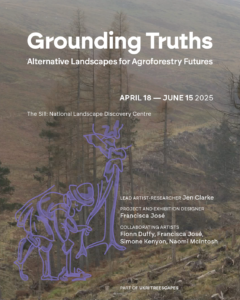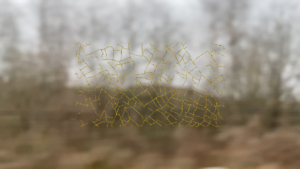Honouring the interdisciplinary and multi-modal focus of the conference, we are proud to offer three distinctive plenary sessions.
Plenary 1: Nikita Simpson – Project Tension
“Project Tension” explores the embodied and psychic cost of environmental change in the Western Himalayas, centring the experiences of the Gaddi tribal community who practice shepherding in its Dhaula Dhar range. It is an artistic render of ethnographic monograph ‘Tension’, written by anthropologist Dr. Nikita Simpson – forthcoming with Duke University Press. Soujanyaa Boruah, Assamese new media artist, and Shyam Lal, Gaddi tribal shepherd and artist, created this immersive art installation inspired by the content and themes of the book upon being awarded a Himalayan Fellowship from Foundation for Indian Contemporary Art (FICA) in 2023. It was included in the “The shape of the wind is a tree” group exhibition curated by FICA in Delhi in 2024. The formative research for the installation was piloted with the support of Research Culture Fund from SOAS, with which the duo and the anthropologist explored the parallels between mental distress of the Gaddi pastoral community and their changing ecological habitat.
Plenary 2: Keynote speaker Jennifer Clarke
Dr. Jennifer (Jen) Clarke, Associate Professor at Gray’s School of Art, is an anthropologist, artist, and transdisciplinary researcher. Her work addresses environmental and social issues, by combining art and anthropology. Jen currently leads artistic research for the UKRI-funded Agroforestry Futures Treescapes project, reimagining our relationships with forests and farming futures. Grounded in feminist approaches, her work challenges existing narratives and creates opportunities for alternative perspectives.




Jen also collaborates on transnational projects in the UK and Japan, where she has lived and researched since 2003. In 2022, she held a Visiting Professorial Research Fellowship at Tohoku University to develop her project Feminist Hospitalities. Her practice spans analogue, digital, and social art forms, as well as public engagement producing diverse artworks and texts, including moving image, installation, and socially engaged projects that work across languages to create spaces for reflection and action. She writes both academically and creatively, contributing to broader discourses related to her artistic and research practice. Since 2018, she has chaired the Board of the Scottish Sculpture Workshop and co-chaired ANTART, EASA’s Anthropology and the Arts Network (2020–2022).
Plenary 3: Interdisciplinary roundtable panel on ‘Fire and Ash’
FIRE DIALOGUES
Fires generate a visceral response for people experiencing them firsthand. At the same time, fire speaks metaphorically to the urgency, challenge, and energy of a changing world. What if fire is trying to communicate with us? What does it mean to be burned, or to be burned out? What is the alternative?
This plenary session presents a chaired conversation between two scholars, and engaging multiple disciplines. Through dialogue, we weave together distinct perspectives on the topic on fire, in order to see what catches.
The contributors:
Penny Chivas is a dance artist originally from Ngunnawal Country, Australia, who moved to Glasgow in 2010 and since contributed to the Scottish dance scene as a freelance performer, an improviser, and a teacher. Penny was awarded the inaugural Sustainability Award from the RCS for her research into ecopedagogical dance practices. From 2021 to 2024 she toured a solo performance work called ‘Burnt Out‘, both in Scotland and internationally. Devised around lived experiences of Australian bushfires, and particularly of Black Summer 2019-2020, ‘Burnt Out’ encapsulated both the factuality and emotionality of this time. Physical gestures alongside music provided space for audience emotions particularly of grief, anger and loss and following performances space was held afterwards for people to come together and also to highlight actions that could be still undertaken. This was designed to support climate anxiety/distress.
Chivas writes that “Bushfires are fast moving changeable events requiring both preparation and urgent decision making to survive yet also provide iconic photos of their destructive paths. Whilst these images are highly recognisable; it could be argued that little space is given to their emotional understanding and repercussions. Art, like ‘Burnt Out’, occupies a unique space in supporting communal and emotional understanding around fire disasters.”
Aadita Chaudhury is an interdisciplinary writer, researcher, and arts practitioner. Currently a PhD Candidate in the Graduate Program in Science and Technology Studies, at York University, in Canada, her doctoral project focuses on the way ecologists make sense of their work, and what their relationship with their non-human subjects can tell us about their epistemological orientation to the biophysical environment. More specifically, it has involved fieldwork on the work that fire ecologists in California do to manage the presence of fire in landscape, and how narrative surrounding fire get translated across different cultural contexts and spaces. In 2020, she was a virtual resident in the UNIDEE residency program in Cittadellarte – Fondazione Pistoletto in Biella, Italy, exploring visual modes of representation, embodied modes of relating and poetic form in relation to fire/combustion as a phenomenon along with arts practitioners from other disciplines from around the world.
Chivas writes that “Wildfires, such as those in Australia in early 2020 and California in early 2025, reflect a convergence of contemporary ecological and socio-political crises. Seeing fire as a “companion” to human life, can be a way of offering new insights into our evolving relationship with the environment. Drawing on Donna Haraway’s concept of companion species, which emphasizes co-evolution with domesticated animals, my work contends that fire represents a different form of companionship – one that transcends hierarchy, and stabilized notions of temporality and place. Fire, as a companion, not only provides warmth and energy but also acts as a portal, signaling distortions in our collective ecological relationships. Through historical, mythological, and contemporary examples, I reframe fire’s appraisal in technoscientific discourse and challenges the ways we understand our companionship with the more-than-human world”
Bridget Bradley, one of the co-convenors of the conference, will be chairing this roundtable session. Bridget’s work on eco-anxiety, kinship, and climate activism was funded by the Scottish Funding Council in 2021. Drawing on a longer trajectory of work with mental health communities in Britain, with a focus on body-mind relationships, Bridget has since also worked in collaboration with visual artists that use charcoal, drawing here on her this scholarly-creative praxis to think through fire, burning, and their remnants, as a basis for important dialogues on the climate crisis.



